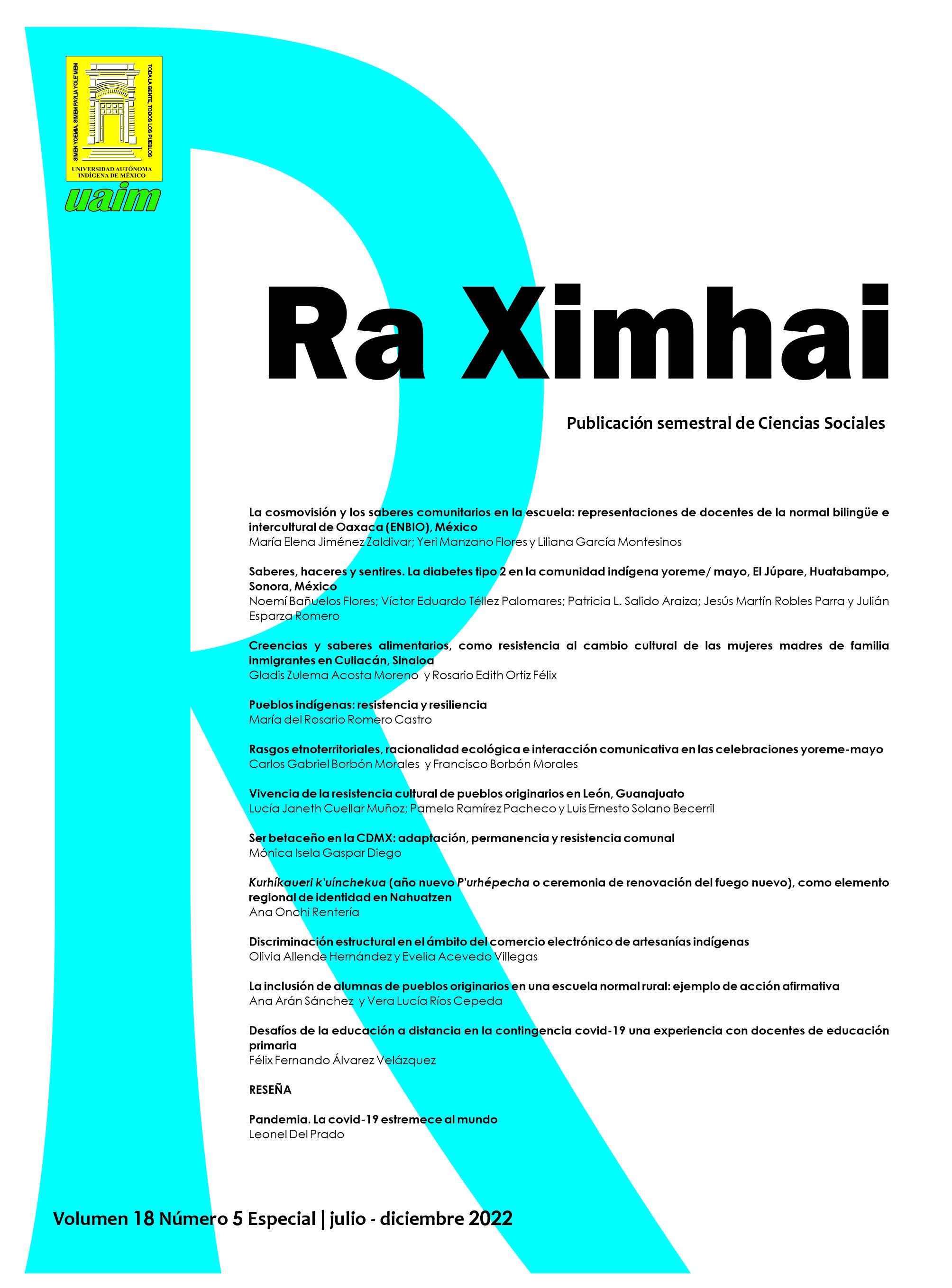Indigenous peoples: resistance and resilience
DOI:
https://doi.org/10.35197/rx.18.05.2022.04.mrKeywords:
original communities, passive submission, survival, identity, adaptationAbstract
In the world there are more than 476 million people who define themselves as indigenous, which are distributed in about 90 countries. In Latin America there are more than 400 groups, each with its own language and culture. The highest concentration of indigenous peoples is found in Asia and the Pacific, they represent 70% of the total and 6% of the world population, but they constitute 15% of those living in poverty (World Bank, 2021). Indigenous peoples have deep, varied knowledge of the natural environment with local roots, traditional indigenous lands and territories shelter and protect nearly 80% of the planet's biodiversity, have ancestral experiences on how to adapt, mitigate and reduce risks arising from climate change and natural disasters. These peoples, also called native peoples, are often the object of discrimination, over the centuries, they have been dispossessed of their lands, territories and resources and consequently have often lost control over their own way of living, for this reason , improving land tenure security, strengthening good governance, promoting public investment in good-quality and culturally appropriate services, and supporting indigenous resilience and livelihood systems are all crucial steps to reduce multidimensional issues of the poverty of the indigenous communities that have physically, morally and culturally resisted centuries of abuses and arbitrariness suffered against them, to preserve their territories, identity, beliefs, customs, languages and culture, in short, their ways of life bequeathed by their ancestors. In this sense, resilience distinguishes two components: resistance against destruction, that is, the ability to protect one's own integrity, under pressure and, on the other hand, beyond resistance, the ability to forge a positive vital behavior despite the difficult circumstances.
Downloads
References
Balderas, O. (2014). Consultado el 02/07/2016 en: http://www.cdi.gob.mx/dmdocuments/nacional_pueblos_indigenas_mexico.pdf
Banco Mundial. (2014). Los Pueblos Indígenas en América Latina. Recuperado de: https://raisg.socioambiental.org/system/files/Documento%20Los%20Pueblos%20Indigenas%20en%20Am%C3%A9rica%20Latina.pdf
Banco Mundial (2021). Recuperado de: https://www.bancomundial.org/es/topic/indigenouspeoples#1
Bonfil, G. (1991). Pensar nuestra cultura. México: Alianza.
Conferencia Preparatoria Global Indígena para la Reunión Plenaria de Alto Nivel de la Asamblea General de las Naciones Unidas, luego conocida como Conferencia Mundial sobre Pueblos Indígenas, 10 al 12 de junio de 2013, Alta, Noruega [http://wcip2014.org/wp-content/uploads/2013/06/Adopted-Alta-outcome-document-with-logoENG.pdf ]
Cyrulnik, B. (2001). La maravilla del dolor: el sentido de la resiliencia. Barcelona: Granica.
Duquesnoy, M. (2014). Resiliencia cultural comunitaria como quehacer político femenino de las mujeres williche del Chaurakawin (Región de los Lagos, Chile). Recuperado de: http://www.scielo.org.mx/scielo.php?script=sci_arttext&pid=S0185-16592014000100004
EZLN. Documentos y comunicados en “Hoy decimos ¡Basta! Declaración de la selva Lacandona”, vol. 1, México, 1994.
INEGI, (2020). Censo de Población y Vivienda 2020. Recuperado de: https://www.inegi.org.mx/.
INPI, (2021). Instituto Nacional de los Pueblos Indígenas. Programa especial derivado del Plan Nacional de Desarrollo 2019-2024. DOF 27/12/2021. Recuperado de: https://www.dof.gob.mx/nota_detalle.php?codigo=5639419&fecha=27/12/2021
Navarrete, F. (2008). Los pueblos indígenas de México Contemporáneo. México: CDI.
Navarrete, F. (2011). La conquista europea y el régimen colonial, en Historia antigua de México, vol. 3, pp. 371-405.
Rutter, G. (1993). Resiliencia: consideraciones conceptuales, en Cuaderno de Investigación. Escuela Profesional de Psicología, Universidad de San M. de Porres, 1993.-Web. Recuperado de: http://www.resilienciamexico2007.blogspot.com.-http/www.mapuexpress.net
Smeke de, Yemy (2000). La resistencia: forma de vida de las comunidades indígenas. El Cotidiano, 16(99), 92-102. ISSN: 0186-1840. Recuperado de: https://www.redalyc.org/articulo.oa?id=32509909
Villarraga, A. (Presidente Fundación Cultura Democrática) (2012). La resistencia indígena: opción de paz. Recuperado de: http://viva.org.co/cajavirtual/svc0320/pdfs/articulo498_320.pdf.
Downloads
Published
How to Cite
Issue
Section
License
Copyright (c) 2022 María del Rosario Romero Castro

This work is licensed under a Creative Commons Attribution-NonCommercial 4.0 International License.
Usted es libre de:
- Compartir — copiar y redistribuir el material en cualquier medio o formato
- Adaptar — remezclar, transformar y construir a partir del material
- La licenciante no puede revocar estas libertades en tanto usted siga los términos de la licencia
Bajo los siguientes términos:
- Atribución — Usted debe dar crédito de manera adecuada , brindar un enlace a la licencia, e indicar si se han realizado cambios . Puede hacerlo en cualquier forma razonable, pero no de forma tal que sugiera que usted o su uso tienen el apoyo de la licenciante.
- NoComercial — Usted no puede hacer uso del material con propósitos comerciales .
- No hay restricciones adicionales — No puede aplicar términos legales ni medidas tecnológicas que restrinjan legalmente a otras a hacer cualquier uso permitido por la licencia.








